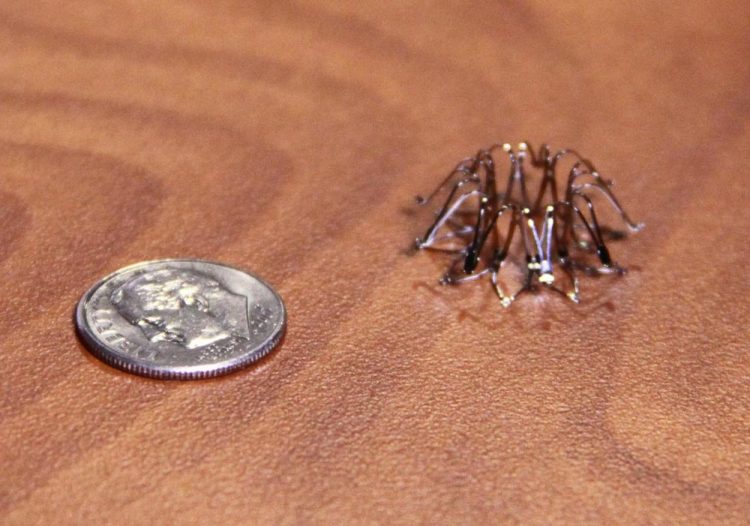First transcatheter implant for diastolic heart failure successful

Next to a dime for perspective, this small wire device is designed to hold open a surgically created hole in the heart of diastolic heart failure patients. Credit: The Ohio State University Wexner Medical Center
Diastolic heart failure (DHF) occurs when the heart muscle becomes stiff and doesn't relax enough to allow blood to flow from the lungs into the heart. This causes blood to back up in the lower left chamber, then the upper left chamber and into the lungs, causing shortness of breath.
“The therapies we use for people with systolic heart failure don't work as well for people with DHF. For decades, we've only been able to manage the symptoms of DHF with diuretics,” said Dr. Rami Kahwash, an advanced heart failure cardiologist and director of the Heart and Vascular Research Organization at Ohio State Ross Heart Hospital.
Kahwash and Dr. Scott Lilly, an interventional cardiologist and director of the Structural Heart Disease Program at Ohio State, were part of the Phase II study that evaluated a dime-size implant intended to relieve the high pressure created by blood backing up from the heart into the lungs.
During a heart catheterization, doctors inserted the tiny, interatrial shunt device in an opening they created between the upper left and right chambers. This diverts some of the blood from the high pressure left atrial chamber to the low pressure right atrial chamber, much like a detour around a traffic jam.
The study randomized 44 DHF patients at multiple centers nationwide. Participants received either the treatment device or a sham procedure. After one month, patients were evaluated by comparing pulmonary capillary wedge pressure (PCWP) readings during right heart catheterization exercise. Elevated PCWP readings indicate failure of the left ventricle.
Researchers reported that the interatrial shunt device reduced PCWP readings by 3.5 mmHg, compared to a reduction of 0.5 mmHg in the control group.
“This device represents a novel therapy for diastolic heart failure, a condition characterized by lifestyle-limiting breathlessness, and one in which traditional heart failure therapies have not proven effective. If the initial experience is substantiated through ongoing clinical trials, this interatrial shunt device may be an opportunity to improve quality of life and exercise capacity for patients that currently have few other options,” Lilly said.
Risk factors for DHF include high blood pressure, diabetes, obesity and age. Kahwash said it's estimated that within the next five years, DHF will account for more than half of all heart failure cases, and be responsible for more hospital admissions than systolic heart failure.
Ohio State Ross Heart Hospital is already recruiting patients in the next phase of the clinical trials testing the interatrial shunt device, which is made by Corvia Medical Inc..
Media Contact
Drew Schaar
Drew@mediasourcetv.com
614-932-9950
Media Contact
All latest news from the category: Medical Engineering
The development of medical equipment, products and technical procedures is characterized by high research and development costs in a variety of fields related to the study of human medicine.
innovations-report provides informative and stimulating reports and articles on topics ranging from imaging processes, cell and tissue techniques, optical techniques, implants, orthopedic aids, clinical and medical office equipment, dialysis systems and x-ray/radiation monitoring devices to endoscopy, ultrasound, surgical techniques, and dental materials.
Newest articles

A universal framework for spatial biology
SpatialData is a freely accessible tool to unify and integrate data from different omics technologies accounting for spatial information, which can provide holistic insights into health and disease. Biological processes…

How complex biological processes arise
A $20 million grant from the U.S. National Science Foundation (NSF) will support the establishment and operation of the National Synthesis Center for Emergence in the Molecular and Cellular Sciences (NCEMS) at…

Airborne single-photon lidar system achieves high-resolution 3D imaging
Compact, low-power system opens doors for photon-efficient drone and satellite-based environmental monitoring and mapping. Researchers have developed a compact and lightweight single-photon airborne lidar system that can acquire high-resolution 3D…





















